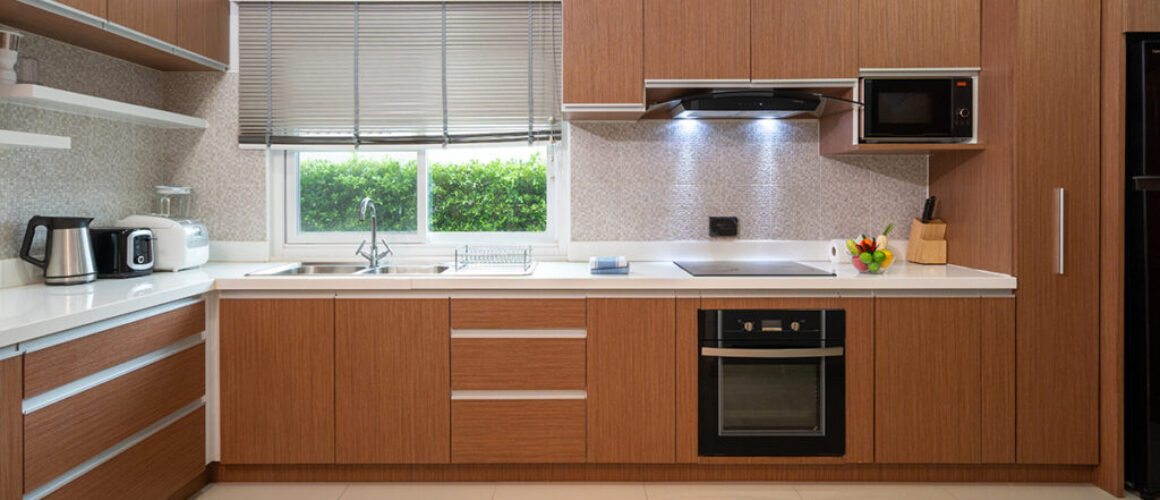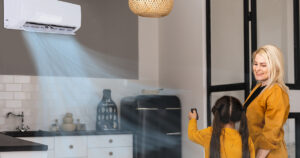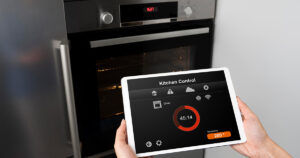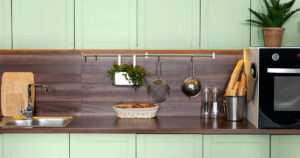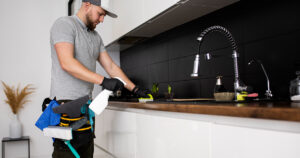How to Design an Energy Efficient Kitchen
Everyone keeps saying that the kitchen is the heart of every home. It’s the spot where we rustle up those hearty meals and create lasting memories. But did you know that cooking alone accounts for about 35% of a restaurant’s energy usage? That’s a significant amount of energy devoted to our culinary endeavours. But what if there was a way for kitchen design that meets our cooking needs, minimises energy consumption, and helps the environment?
In this blog, we’ll explore kitchen upgrade ideas by creating an energy-efficient kitchen that combines style, functionality, and sustainability. We’ll share practical tips and creative kitchen ideas to transform your kitchen into a green oasis without compromising its visual appeal.
Get ready to discover how to revamp your cooking space with intelligent choices and innovative kitchen designs. We’ll cover everything from strategic layouts and eco-friendly materials to clever storage solutions and stylish accents. By the end, you’ll have the knowledge and inspiration to create an energy-efficient kitchen remodel that saves you money and reduces your environmental impact.
Planning the Layout
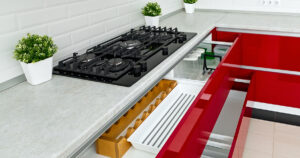
One of the key factors in designing an efficient and functional kitchen is planning the layout. The layout determines how smoothly you can move around the space and access essential elements while cooking. By optimising the kitchen layout, you can create a workspace that enhances productivity and efficiency. Let’s discuss the importance of a well-thought-out kitchen layout and considerations for maximising workflow and accessibility.
Optimising the Kitchen Layout for Efficiency
When creating an efficient kitchen, the layout plays a crucial role. By strategically arranging key elements, you can streamline your workflow and make the most of your available space. Start by considering the work triangle concept, which involves placing the farmhouse sink, stove, and refrigerator in a triangular formation for easy access. Additionally, think about the placement of your kitchen island, ensuring it doesn’t disrupt the flow of movement. Utilise ample quartz countertops space for meal prep and consider installing open shelves or paint-dated kitchen cabinets for easy access to frequently used items. By incorporating these tips and utilising online resources like BestOnlineCabinets, you can design a kitchen remodel that looks great and supports your everyday cooking activities.
Considerations for Workflow and Accessibility
Efficient workflow and accessibility are key factors in designing a kitchen that meets your needs. Consider how you move around the kitchen and ensure the layout supports a smooth and logical flow. Start by analyzing the tasks you perform most frequently and arrange your workspace accordingly—place utensils, cutting boards, and other tools within easy reach. Consider a galley layout with upper cabinets for additional storage if you have limited space. Utilise neutral tones and natural light to create an open, airy atmosphere that enhances visibility and makes your kitchen feel more spacious. These kitchen design ideas, such as maximising counter space and ensuring a logical flow, will significantly enhance the efficiency of your cooking area.
Assessing Energy Consumption
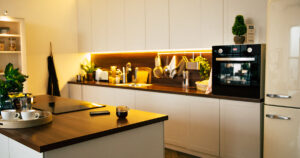
Before you can effectively reduce energy consumption in your kitchen, it’s essential to assess your current usage patterns of the house. By understanding how energy is consumed within your culinary space, you can identify areas for improvement and make informed decisions to enhance energy efficiency. In this section, we will explore the importance of assessing energy consumption and provide insights into understanding kitchen energy usage. We will also guide you through an energy audit, a valuable tool for identifying energy-saving opportunities.
Understanding Kitchen Energy Usage
A clear understanding of how energy is used in your kitchen is important to reduce energy consumption effectively. It would help if you started examining the energy usage of major appliances such as refrigerators, ovens, and dishwashers. Consider their energy ratings and look for energy-efficient models when upgrading. Additionally, assess the usage patterns of smaller stainless steel appliances, lighting fixtures, and ventilation systems in-house. Identify any inefficient or outdated equipment contributing to unnecessary energy waste. This way, you can make proper decisions on where to focus your efforts to maximise efficiency and reduce your environmental impact.
Conducting an Energy Audit
An energy audit is a systematic assessment of your kitchen’s energy consumption. Begin by tracking your energy bills to identify any unusual patterns or spikes in usage. Assess your insulation, windows, and doors for potential leaks or drafts contributing to energy loss. Evaluate the efficiency of your appliances, checking for any signs of wear and tear or outdated models. Consider installing energy-saving technologies such as LED lighting or smart thermostats to optimise energy usage. By conducting a thorough energy audit, you can pinpoint areas for improvement and develop a tailored plan to minimise energy waste and create a more energy-efficient kitchen environment.
Lighting Solutions

Well-designed lighting enhances your space’s aesthetics and contributes to a productive and inviting culinary environment. So you need to consider that choosing the right lighting solutions for your kitchen can significantly impact both functionality and energy efficiency. Let’s shed some light on the subject and discover how to illuminate your cooking space effectively.
Optimal Lighting Choices
When it comes to lighting choices for your kitchen, LED lighting stands out as an excellent option. LED lights are energy-efficient, long-lasting, and versatile, making them ideal for illuminating your cooking area. Their low energy consumption helps reduce electricity costs while providing ample brightness for meal preparation and cooking. Consider incorporating LED lighting in your kitchen to save energy and create a visually appealing and well-lit space.
Utilising Natural Light Effectively
Natural light can significantly enhance your kitchen’s ambience and energy efficiency. Please make the most of any available windows by keeping them unobstructed and utilising light-filtering treatments. You can also position work areas near windows to maximise natural light exposure during the day. Additionally, consider using light-coloured surfaces and reflective materials to bounce more light throughout the space, creating a brighter, more open atmosphere. One more tip on improving your kitchen’s lighting while adding a touch of nature is to add a few low-maintenance plants like succulents, spider plants, and pothos. These greens thrive in different light levels and are able to brighten up your kitchen. Remember not to place them near any heat-generated appliances!
Installing Energy-Efficient Fixtures
When selecting lighting fixtures, opt for energy-efficient options. Look for fixtures with the ENERGY STAR label, as they meet stringent efficiency standards. Choose LED or compact fluorescent bulbs over traditional incandescent bulbs, as they consume less energy and last longer. Consider installing dimmer switches to adjust lighting levels based on specific tasks or mood requirements. You can reduce electricity consumption by utilising energy-efficient fixtures and creating a well-lit kitchen that meets your needs.
Appliance Selection and Placement

Select the right appliances and strategically place them in your kitchen. So you can have a significant impact on energy efficiency and overall functionality. In this section, we will delve into the importance of appliance selection and placement, offering insights into choosing energy-efficient models and optimising their arrangement within your culinary space.
Choosing Energy-Efficient Appliances
When it comes to selecting appliances for your kitchen, prioritise energy efficiency. Look for stainless steel appliances with high Energy Star ratings that consume less energy while delivering top performance. Consider the size of the appliances, opting for models that meet your needs without unnecessary excess capacity. Explore innovative features such as smart technologies that can further enhance energy efficiency. By choosing energy-efficient appliances, you can significantly reduce energy consumption in your kitchen while enjoying the latest technological advancements.
Optimising Appliance Placement
The placement of your kitchen appliances plays a crucial role in optimising both workflow and energy efficiency. Begin by considering the work triangle concept, which involves strategically positioning the sink, stove, and refrigerator for easy access and minimal movement. Remember ventilation requirements for range hoods or ovens to ensure efficient airflow. Additionally, avoid placing heat-generating appliances near refrigerators or other sensitive equipment. By strategically arranging your appliances, you can improve the functionality of your kitchen while minimising energy waste.
Making smart decisions about appliance selection and placement allows you to enjoy the benefits of modern technology while minimising your carbon footprint and energy costs.
Water Conservation
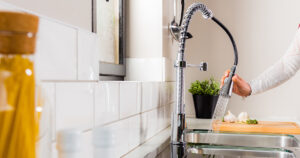
Water conservation is a crucial aspect of creating an environmentally sustainable kitchen. You can reduce water waste by implementing water-saving strategies and utilising efficient faucets and fixtures while maintaining a functional and stylish space. Follow us to explore the importance of water conservation in the kitchen and provide insights into using water-efficient faucets and fixtures and incorporating water-saving techniques.
Using Water-Efficient Faucets and Fixtures
Water-efficient faucets and fixtures are essential to conserving water in your kitchen. Look for products with the WaterSense label, as they are certified to meet high water efficiency standards. These fixtures are designed to reduce water flow without compromising performance, allowing you to save water while performing daily tasks such as washing dishes or hands.
Incorporating Water-Saving Techniques
In addition to using water-efficient fixtures, incorporating simple yet effective water-saving techniques can further enhance water conservation in your kitchen. Start by avoiding running water unnecessarily, such as when washing dishes or rinsing vegetables. Instead, use a basin or plug the farmhouse sink to minimise water waste. Consider installing aerators on faucets to reduce water flow while maintaining adequate pressure. Utilise dishwasher and washing machine settings that promote water efficiency, such as eco or water-saving cycles. By adopting these water-saving techniques, you can significantly impact water conservation while maintaining the functionality of your kitchen.
Heating and Cooling Efficiency
Efficient heating and cooling are necessary for a comfortable and eco-friendly kitchen. You can create a sustainable and cost-effective environment by focusing on insulation, weatherisation, and utilising energy-efficient systems. Let’s explore these strategies to optimise your kitchen’s heating and cooling efficiency.
Insulation and Weatherisation Tips
Effective insulation and weatherisation play a significant role in maintaining a comfortable temperature within your kitchen while minimising energy waste. Start by ensuring proper insulation in walls, ceilings, and floors to prevent heat transfer. Seal gaps or cracks around windows and doors to prevent drafts and maintain consistent temperatures. Consider installing double-pane windows for enhanced thermal insulation. Use weatherstripping to seal gaps in windows and doors.
Utilising Energy-Efficient Systems
Investing in energy-efficient systems for your kitchen to maximise heating and cooling efficiency is important. Choose appliances such as HVAC units and air conditioners with high energy efficiency ratings. Look for systems that utilise smart thermostats or zoning capabilities, allowing you to control temperatures more precisely and reduce energy waste. Consider installing ceiling fans to enhance air circulation and reduce the reliance on cooling systems. By utilising energy-efficient systems, you can optimise temperature control and minimise energy consumption and associated costs in your kitchen.
Smart Technology Integration
Integrating innovative technology into your kitchen brings convenience, efficiency, and energy management to a new level. You can enhance energy efficiency and streamline kitchen operations by incorporating smart home devices and utilising remote monitoring and control capabilities.
Managing Energy with Smart Home Devices
Smart home devices offer innovative ways to manage energy consumption in your kitchen. From smart thermostats that adjust temperature settings based on occupancy to smart plugs that enable scheduling and remote control of appliances, these devices allow for efficient energy management. Use smart power strips to eliminate standby power consumption and optimise energy usage. With voice commands or smartphone apps, you can effortlessly control lights and appliances and monitor energy usage.
Remote Monitoring and Control
Remote monitoring and control capabilities provided by smart technology offer convenience and energy efficiency. Monitor energy usage, receive notifications, and adjust settings from anywhere using your smartphone or tablet. Seamlessly integrate QR codes into your monitoring system, allowing quick scans for detailed energy reports or customized settings. Remotely turn off lights or appliances accidentally left on, ensuring energy isn’t wasted. Adjust temperature settings before arriving home, optimising comfort while saving energy. The remote control allows you to adapt and manage your kitchen’s energy consumption according to your needs. With remote monitoring and control, you can stay connected to your kitchen and make energy-conscious decisions effortlessly.
Sustainable Materials and Finishes
Incorporating sustainable materials and finishes in your kitchen design not only promotes environmental responsibility but also adds a touch of elegance and longevity to your space.
Selecting Eco-Friendly Materials
When choosing materials for your kitchen, prioritise eco-friendly options. Opt for cabinets made from reclaimed or sustainably sourced wood. Consider granite countertops crafted from recycled glass, bamboo, or responsibly harvested stone like subway tile backsplash. Select flooring materials such as cork or bamboo that are renewable and durable. Look for low or zero VOC (Volatile Organic Compounds) paints and adhesives to reduce harmful emissions.
Choosing Sustainable Finishes
Sustainable finishes play a significant role in creating an environmentally friendly kitchen. Look for water-based or low-VOC sealants and varnishes when finishing wood surfaces. Opt for natural finishes such as linseed oil or beeswax to enhance the beauty of your wood countertops or marble countertops. Consider using recycled glass tile backsplash or subway tiles.
Maintenance and Upkeep
For your kitchen’s long-term efficiency and sustainability, you need to have proper maintenance and upkeep. By implementing these tips, you can ensure optimal performance while minimising energy waste.
Regular Maintenance for Efficiency
Regular maintenance practices help keep your kitchen in optimal condition, ensuring efficiency and functionality. Clean and maintain appliances to remove dust and debris that can hinder performance. Check and clean range hoods and ventilation system filters to maintain proper airflow. Inspect seals on refrigerators and freezers to prevent energy loss. Regularly clean and unclog plumbing fixtures to maintain water flow efficiency. By implementing regular maintenance routines, you can extend the lifespan of your kitchen appliances, enhance energy efficiency, and avoid costly repairs.
Long-term Energy-Saving Tips
In addition to regular maintenance, long-term energy-saving tips can significantly reduce energy consumption in your kitchen. Opt for energy-efficient appliances with high Energy Star ratings when upgrading or replacing old ones. Install programmable thermostats to schedule temperature adjustments based on usage patterns. Utilise natural light during the day by keeping curtains open and using reflective surfaces. Implement smart power strips to prevent energy wastage from devices on standby mode.
Conclusion
Designing an energy-efficient kitchen is a journey that combines functionality, sustainability, and style. Throughout this blog, we have explored various aspects of creating an eco-friendly culinary space. Each element plays a vital role in reducing energy consumption and promoting environmental responsibility, from optimising the kitchen layout and selecting energy-efficient appliances to incorporating sustainable materials and utilising smart technology.
By strategically planning the layout, considering workflow and accessibility, and incorporating efficient lighting solutions, you can create a well-designed kitchen remodel that enhances efficiency and minimises energy waste. You can reduce environmental impact by assessing energy consumption, implementing water conservation techniques, and optimising heating and cooling efficiency.
Integrating smart technology, using sustainable materials and finishes, and prioritising regular maintenance and upkeep are essential for a genuinely energy-efficient kitchen. By following these guidelines and incorporating these practices, you can transform your kitchen into a sustainable and environmentally conscious space while enjoying the benefits of energy savings and enhanced functionality.


